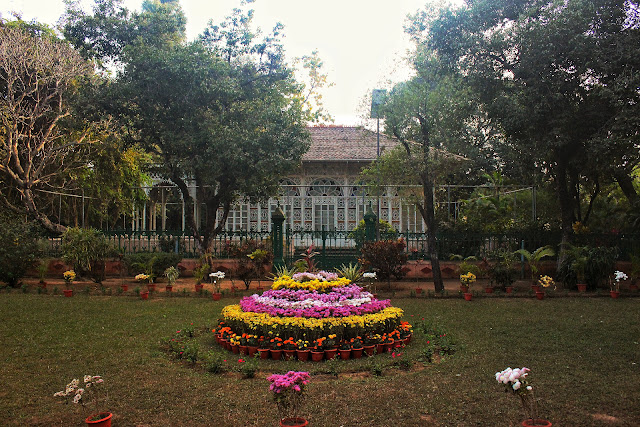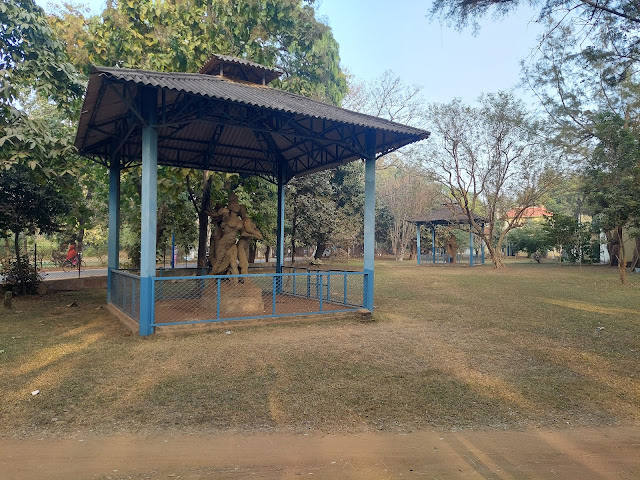1.
I had hardly explored Kolkata beyond the internet of my relatives in Burra Bazaar. Time time around, despite the fact that I was visiting the city after close to two decades, I still decided to carve out two days to visit Shantiniketan. Moreover, as I slip into the slowness of my forties, I have been trying to overcome my innate reluctance of solo travel.
Solicited help from family to travel to Shantiniketan was available, however, my confidence to venture grew deeper upon finding a friend Suryasarathi from Kolkata who enthusiastically signed up to accompany me on this overnight trip. We took off to Bolpur-Shantiniketan via a morning passenger train from Howrah during early January winter. Looking over the city landscape transform into red agricultural fields we caught up on our five years of recessed conversation over the journey while also munching upon jhaal muri. Bolpur arrived pretty much on time, and greeted us rather graciously, in brightly painted murals over the asbestos-sheet canvases of the station platform, already announcing itself as the place of artistic thought.
Suryasarathi had booked our stay closer to the Viswa-bharati campus. My boundaries of navigation in the limits of language only dawned upon me as Surya spoke to the rickshaw driver negotiating his way into Bolpur. We checked into our rather modest homestay by the afternoon, and rushed through lunch there so that we could catch a glimpse of the campus before the winter sun fell down. We walked our way to the campus through the quiet neighbourhood finally reaching the Upasana Griha in Sriniketan, and the concrete sculptures of Ramkinkar Baij.


2.
Bolpur is a small town about two hours away from Kolkata in Birbhum district of West Bengal. In 1863, Rabindranath Tagore's father Debendranath Tagore purchased a large piece of land in Bhubandanga in Bolpur, where he established an ashram to preach the principles of Brahmo Samaj (founded along with Raja Ram Mohan Roy) - that he called 'Shantiniketan'. Brahmo Samaj was the defining institution of the Bengal Renaissance of the mid 18th century that was born in, and sought to bring a sociopolitical awakening in the fields of intellectual inquiry, aiding social reform in the light of modern ideals of secularism and humanism. While Kolkata remained the centre of British power, Bolpur went on to incubate the a spiritual retreat of Shantiniketan (the abode of peace) in the lap of nature that would emerge to be what is now the Viswa-Bharati University.
The reform movement of Bengal Renaissance was spearheaded by upper class Hindus and some notable Muslims, largely zamindars (Thakurs) with the ability to afford land holdings. The Tagore family also had a long standing relationship with the British, benefitting through economic and cultural exchanges since early 18th century. Tagore himself went to study Law at the University College London during 1878 and returned back to India by 1883 without a degree. While at the UCL, he found himself indulging in English/Scottish/ Irish literature, music and the arts, and took up to studying plays of Shakespeare by himself. Tagore's aversion to rote learning is said to have inspired him to establish the Patha Bhavana at Shantiniketan in 1901 - where he founded the school with only five students.
Despite being aligned with the economic forces of the time and belonging to the upper class themselves, the task of making an institution was daunting. Rabindranath tagore is said to have been constantly look for funds to expand the infrastructure of the campus. To that extent, as a colleague anecdotally narrates, Tagore is said to have heaved a sigh of relief to one of his allied collegues seeking funds, upon the hearing of the Nobel prize. "There's a good news, we will be able to now make the building," he said even before he mentioned that he had won a prestigious title himself. He went to several places and people to gather funds after being entitled at the Laureate. While Tagore could not really afford an architect for the planning of the campus, his artist friend Surendranath Kar is supposed to have taken up the task of laying out the buildings.
3.
At a first glance, the architecture of Shantiniketan gives no impression of any sense of Indianness. One does see scattered squatting squarish and rectangular rooms between large tracts of flat land and under big trees. The different buildings, imagined as 'bhavans' are simple shelters that are orthogonal plans pulled up like cakes to modest heights. "Kala bhavan', "Sangeet Bhavan', 'Vinay Bhavan', 'Patha Bhavan' were Sometimes, they have a floor above, connected by external staircases. When many such built blocks come together, they begin to create a nestling of their front and backyards, weaving in the open and closed spaces. The elevations of these modest blocks are highly articulate and adorned in stylistic ways, and moreover, they become canvases to take on the works of art as murals, paintings or sculptures across the entire campus.
In existing literature on the architecture of Shantiniketan, the idea of "ashram" and "cave" have been used often to encapsulate the experience of the place. Indeed, the space with its forest-like lowly populated areas under old huge trees extends a feeling of hermitage. Infact, with the open-air classrooms with defined seatings and plinths under large trees are certainly evoke the feeling of the ancient gurukul, spelling the institution's desire to be amidst to nature. On the other hand, the likeliness of the cave can be observed quite literally in the Kalo Bari - a black house planned by Nandalal Bose, Surendranath Kar and Ramkinker Baij. The building is painted black and reliefs of ancient murals can be seen along its surfaces. Unfortunately, I was not able to see this building, but came across my readings later on.
But when one looks at the other cellular buildings scattered on the campus, a distinct internationalism and eclecticism reeks through its architecture. The Brahmo Samaj guest house, one of the first chambers built by Tagore's father is a shed supported in decorative cast iron structure. It is clearly influenced by the Crystal Palace of the 19th century, although small in size. Not only does it use the material of modernism, but it also uses a vocabulary that was vogue at its time in the West. Many other individually sitting buildings are clearly orthographically planned and functionally raised up in an almost banal fashion. The artist community often likes to draw attention to the stylistic adulation of the elevations - which must have been indeed carefully crafted. The scales of some buildings are lower than usual, and some of these many be inspired from Tagore's travels to South East Asian countries. One can observe that there was an attempt to treat these independently standing halls ('bhavans') as spatial sculptures, but the they remain confused between maintaining the functionality of buildings and interpretation of the building elements into a vocabulary of sculpture. The organisation of space is not seen as the work of architecture, rather architecture is dubbed as the work of creating a functional sculpture, an artful object.
There is a lot of quotation of the vernacular forms. The Bengal roof comes to inform many built forms in the campus. The Taladhwaja is a literal remake of the traditional house. The idea of the verandah is occurs in some places. Early student and faculty accommodations were built in traditional mud and thatch. Bolpur is said to be home to around 41 sacred groves. Infact, Tagore's father was instrumental in afforesting a lot of campus land after procurement. Santhal life is made eternal in the environment of the campus through the fantastic gritty concrete sculptures of Nandlal Bose. While humanity was just turning to concrete for creating shelters, Bose makes it into his material of art. Following this legacy, many other murals on campus can be seen shaping artistic expression using everyday building materials including aggregate, terracotta tiles, china mosaic, dried grass and so on. Building elements continue to be rendered refreshingly in some cases. For example, one of the shoplines we sat down for our evening snack was creatively crafted using asbestos and tin roofing sheets - which, while shacky, gave the impression of a Mondrian composition.

















































